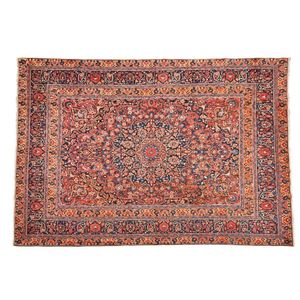Worn Persian Fereghan Rug with Boteh Motifs
An old hand knotted Persian Fereghan rug, the field decorated with small boteh motifs in colours of red, blue and old ivory. Worn. 126 cm x 220 cm
You must be a subscriber, and be logged in to view price and dealer details.
Subscribe Now to view actual auction price for this item
When you subscribe, you have the option of setting the currency in which to display prices to $Au, $US, $NZ or Stg.
This item has been sold, and the description, image and price are for reference purposes only.
- Ivory - Ivory is a hard white material that comes from the tusks of elephants, mammoth, walrus and boar, or from the teeth of hippopotamus and whales. The ivory from the African elephant is the most prized source of ivory. Although the mammoth is extinct, tusks are still being unearthed in Russia and offered for sale.
Ivory has been used since the earliest times as a material for sculpture of small items, both in Europe and the east, principally China and Japan.
In Asia ivory has been carved for netsuke, seals, okimono, card cases, fan supports, animals and other figures and even as carved tusks.
In the last 200 years in Europe ivory has been used to carve figures, for elaborate tankards, snuff boxes, cane handles, embroidery and sewing accessories, in jewellery and as inlay on furniture. Its more practical uses include being used for billiard balls, buttons, and a veneers on the top of piano keys.
The use and trade of elephant ivory have become controversial because they have contributed to Due to the decline in elephant populations because of the trade in ivory, the Asian elephant was placed on Appendix One of the Convention on International Trade in Endangered Species (CITES), in 1975, and in January 1990, the African elephant was similarly listed. Under Appendix One, international trade in Asian or African elephant ivory between member countries is forbidden. Unlike trade in elephant tusks, trade in mammoth tusks is legal.
Since the invention of plastics, there have been many attempts to create an artificial ivory - Boteh Motif - A boteh motif is a design element commonly found in traditional Persian and Central Asian rugs. It features a teardrop or pear shaped figure with a curved upper end and a pointed lower end, often with a curved stem and tendrils or leaves radiating out from the bottom. The boteh is thought to be a representation of a cypress tree, a symbol of spiritual growth and eternal life in ancient Persian culture, but it's also used as an ornamental motif in various art forms. It is also called Paisley design in Britain after the name of the town in Scotland famous for its weaving industry in the 19th century.
This item has been included into following indexes:
Visually similar items

A Mahal carpet, early 20th century, 370 x 285 cm
Sold by
in
for
You can display prices in $Au, $US, $NZ or Stg.

A hand knotted Persian Hamadan rug, with three central medallions, rich colours on a tomato red ground. 210 x 156 cm
Sold by
in
for
You can display prices in $Au, $US, $NZ or Stg.

A good large hand knotted Persian rug, of ornate Kirman design, with central circular medallion on a scroll and intense floral field. Triple borders of rosettes and boteh leaves, 410 cm x 300 cm
Sold by
in
for
You can display prices in $Au, $US, $NZ or Stg.

A Persian Enjilass rug, 155 cm x 107 cm
Sold by
in
for
You can display prices in $Au, $US, $NZ or Stg.
